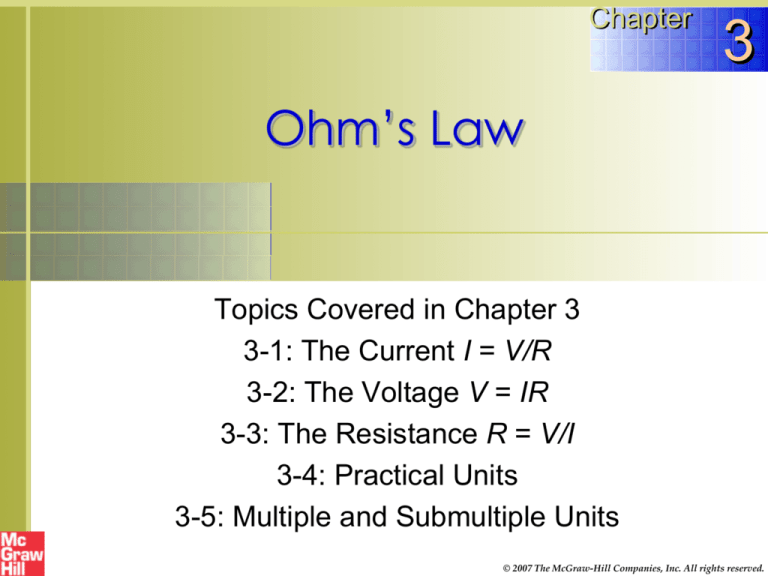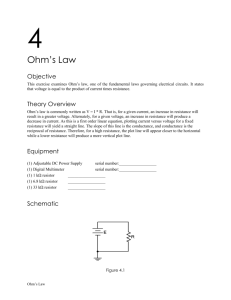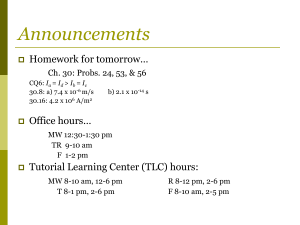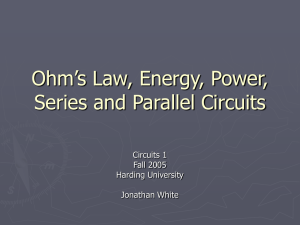
Chapter
3
Ohm’s Law
Topics Covered in Chapter 3
3-1: The Current I = V/R
3-2: The Voltage V = IR
3-3: The Resistance R = V/I
3-4: Practical Units
3-5: Multiple and Submultiple Units
© 2007 The McGraw-Hill Companies, Inc. All rights reserved.
Topics Covered in Chapter 3
3-6: The Linear Proportion between V and I
3-7: Electric Power
3-8: Power Dissipation in Resistance
3-9: Power Formulas
3-10: Choosing a Resistor for a Circuit
3-11: Electric Shock
3-12: Open-Circuit and Short-Circuit Troubles
McGraw-Hill
© 2007 The McGraw-Hill Companies, Inc. All rights reserved.
Ohm’s Law
Ohm's law states that, in an
electrical circuit, the current
passing through most
materials is directly
proportional to the potential
difference applied across
them.
3-1—3-3: Ohm’s Law Formulas
There are three forms of
Ohm’s Law:
I = V/R
V = IR
R = V/I
where:
I = Current
V = Voltage
R = Resistance
Fig. 3-4: A circle diagram to help in memorizing the Ohm’s Law formulas V = IR, I = V/R,
and R= V/I. The V is always at the top.
Copyright © The McGraw-Hill Companies, Inc. Permission required for reproduction or display.
3-1: The Current I = V/R
I = V/R
In practical units, this law
may be stated as:
amperes = volts / ohms
Fig. 3-1: Increasing the applied voltage V produces more current I to light the bulb with
more intensity.
Copyright © The McGraw-Hill Companies, Inc. Permission required for reproduction or display.
3-4: Practical Units
The three forms of Ohm’s law can be used to define the
practical units of current, voltage, and resistance:
1 ampere = 1 volt / 1 ohm
1 volt = 1 ampere × 1 ohm
1 ohm = 1 volt / 1 ampere
3-4: Practical Units
Applying Ohm’s Law
?
20 V
4W
V
I R
20 V
=5A
I =
4W
1A
12 W V = 1A × 12 W = 12 V
?
3A
6V
?
6V
=2W
R =
3A
Problem
Solve for the resistance, R, when V and I are known
a. V = 14 V, I = 2 A, R = ?
b. V = 25 V, I = 5 A, R = ?
c. V = 6 V, I = 1.5 A, R = ?
d. V = 24 V, I = 4 A, R = ?
3-5: Multiple and Submultiple Units
Units of Voltage
The basic unit of voltage is the volt (V).
Multiple units of voltage are:
kilovolt (kV)
1 thousand volts or 103 V
megavolt (MV)
1 million volts or 106 V
Submultiple units of voltage are:
millivolt (mV)
1-thousandth of a volt or 10-3 V
microvolt (μV)
1-millionth of a volt or 10-6 V
3-5: Multiple and Submultiple Units
Units of Current
The basic unit of current is the ampere (A).
Submultiple units of current are:
milliampere (mA)
1-thousandth of an ampere or 10-3 A
microampere (μA)
1-millionth of an ampere or 10-6 A
3-5: Multiple and Submultiple Units
Units of Resistance
The basic unit of resistance is the Ohm (Ω).
Multiple units of resistance are:
kilohm (kΩ)
1 thousand ohms or 103 Ω
Megohm (MΩ)
1 million ohms or 106 Ω
Problem
How much is the current, I, in a 470-kΩ resistor if its
voltage is 23.5 V?
How much voltage will be dropped across a 40 kΩ
resistance whose current is 250 µA?
3-6: The Linear Proportion between
V and I
The Ohm’s Law formula I = V/R states that V and I are
directly proportional for any one value of R.
Fig. 3.5: Experiment to show that I increases in direct proportion to V with the same R. (a)
Circuit with variable V but constant R. (b) Table of increasing I for higher V. (c) Graph of V
and I values. This is a linear volt-ampere characteristic. It shows a direct proportion
between V and I.
Copyright © The McGraw-Hill Companies, Inc. Permission required for reproduction or display.
3-6: The Linear Proportion between
V and I
When V is constant:
I decreases as R increases.
I increases as R decreases.
Examples:
If R doubles, I is reduced by half.
If R is reduced to ¼, I increases by 4.
This is known as an inverse relationship.
3-6: The Linear Proportion between
V and I
Linear Resistance
A linear resistance has a constant value of ohms. Its R
does not change with the applied voltage, so V and I
are directly proportional.
Carbon-film and metal-film resistors are examples of
linear resistors.
3-6: The Linear Proportion between
V and I
1W
2W
+
0 to 9 Volts
_
2W
Amperes
4
3
2
4W
1
0 1 2 3 4 5 6 7 8 9
Volts
The smaller the resistor, the steeper the slope.
3-6: The Linear Proportion between
V and I
Amperes
Nonlinear Resistance
In a nonlinear resistance, increasing the applied V
produces more current, but I does not increase in the
same proportion as the increase in V.
Example of a Nonlinear Volt–Ampere Relationship:
As the tungsten filament in a light bulb gets hot, its
resistance increases.
Volts
3-6: The Linear Proportion between
V and I
Another nonlinear resistance is a thermistor.
A thermistor is a resistor whose resistance value
Thermistor
Copyright © The McGraw-Hill Companies, Inc. Permission required for reproduction or display.
Amperes
changes with its operating temperature.
As an NTC (negative temperature coefficient)
thermistor gets hot, its resistance decreases.
Volts
3-7: Electric Power
The basic unit of power is the watt (W).
Multiple units of power are:
kilowatt (kW):
1000 watts or 103 W
megawatt (MW):
1 million watts or 106 W
Submultiple units of power are:
milliwatt (mW):
1-thousandth of a watt or 10-3 W
microwatt (μW):
1-millionth of a watt or 10-6 W
3-7: Electric Power
Work and energy are basically the same, with identical
units.
Power is different. It is the time rate of doing work.
Power = work / time.
Work = power × time.
3-7: Electric Power
Practical Units of Power and Work:
The rate at which work is done (power) equals the
product of voltage and current. This is derived as
follows:
First, recall that:
1 volt =
1 joule
1 coulomb
and 1 ampere =
1 coulomb
1 second
3-7: Electric Power
Power = Volts × Amps, or
P=V×I
1 joule
1 joule
1 coulomb
×
=
Power (1 watt) =
1 second
1 coulomb
1 second
3-7: Electric Power
Kilowatt Hours
The kilowatt hour (kWh) is a unit commonly used for
large amounts of electrical work or energy.
For example, electric bills are calculated in kilowatt
hours. The kilowatt hour is the billing unit.
The amount of work (energy) can be found by
multiplying power (in kilowatts) × time in hours.
3-7: Electric Power
To calculate electric cost, start with the power:
An air conditioner operates at 240 volts and 20
amperes.
The power is P = V × I = 240 × 20 = 4800 watts.
Convert to kilowatts:
4800 watts = 4.8 kilowatts
Multiply by hours: (Assume it runs half the day)
energy = 4.8 kW × 12 hours = 57.6 kWh
Multiply by rate: (Assume a rate of $0.08/ kWh)
cost = 57.6 × $0.08 = $4.61 per day
Problem
How much is the output voltage of a power supply if it
supplies 75 W of power while delivering a current of 5
A?
How much does it cost to light a 300-W light bulb for
30 days if the cost of the electricity is 7¢/kWh.
3-8: Power Dissipation in Resistance
When current flows in a resistance, heat is produced
from the friction between the moving free electrons and
the atoms obstructing their path.
Heat is evidence that power is used in producing
current.
3-8: Power Dissipation in Resistance
The amount of power dissipated in a resistance may be
calculated using any one of three formulas, depending
on which factors are known:
P = I2×R
P = V2 / R
P = V×I
Problem
Solve for the power, P, dissipated by the resistance,
R
I = 1 A, R = 100Ω , P = ?
b. I = 20 mA, R = 1 kΩ , P = ?
c. V = 5 V, R = 150Ω , P = ?
d. V = 22.36 V, R = 1 kΩ , P = ?
a.
How much power is dissipated by an 8-Ω load if the
current in the load is 200 mA?
3-9: Power Formulas
There are three basic power formulas, but each can be
in three forms for nine combinations.
Where:
P = Power
P VI
P I 2R
V2
P
R
P
I
V
P
R 2
I
V2
R
P
P
V
I
P
I
R
V PR
V = Voltage
I = Current
R=Resistance
3-9: Power Formulas
Combining Ohm’s Law and the Power Formula
All nine power formulas are based on Ohm’s Law.
V = IR
I=V
R
Substitute IR for V to obtain:
P = VI
= (IR)I
= I2R
P = VI
3-9: Power Formulas
Combining Ohm’s Law and the Power Formula
Substitute V/R for I to obtain:
P = VI
= V × V/ R
= V2 / R
3-9: Power Formulas
Applying Power Formulas:
5A
20 V
P = VI = 20 × 5 = 100 W
4W
2
P = I R = 25 × 4 = 100 W
2
V
400
= 100 W
=
P=
R
4
Problem
What is the resistance of a device that dissipates 1.2
kW of power when its current is 10 A?
How much current does a 960 W coffeemaker draw
from the 120 V power line?
What is the resistance of a 20 W, 12 V halogen lamp?
3-10: Choosing a Resistor
for a Circuit
Follow these steps when choosing a resistor for a
circuit:
Determine the required resistance value as R = V / I.
Calculate the power dissipated by the resistor using any
of the power formulas.
Select a wattage rating for the resistor that will provide
an adequate cushion between the actual power
dissipation and the resistor’s power rating.
Ideally, the power dissipation in a resistor should never
be more than 50% of its power rating.
Problem
Determine the required resistance and appropriate
wattage rating of a carbon-film resistor to meet the
following requirements. The resistor has a 54-V IR
drop when its current is 20 mA. The resistors available
have the following wattage ratings:
1/8 W, 1/4 W, 1/2 W, 1 W, and 2 W.
3-10: Choosing a Resistor
for a Circuit
Maximum Working Voltage Rating
A resistor’s maximum working voltage rating is the
maximum voltage a resistor can withstand without
internal arcing.
The higher the wattage rating of the resistor, the higher
the maximum working voltage rating.
3-10: Choosing a Resistor
for a Circuit
Maximum Working Voltage Rating
With very large resistance values, the maximum
working voltage rating may be exceeded before the
power rating is exceeded.
For any resistor, the maximum voltage which produces
the rated power dissipation is:
Vmax = Prating × R
Exceeding Vmax causes the resistor’s power dissipation
to exceed its power rating
3-11: Electric Shock
When possible, work only on circuits that have the
power shut off.
If the power must be on, use only one hand when
making voltage measurements.
Keep yourself insulated from earth ground.
Hand-to-hand shocks can be very dangerous because
current is likely to flow through the heart!
3-12: Open-Circuit and
Short-Circuit Troubles
An open circuit has zero current flow.
Copyright © The McGraw-Hill Companies, Inc. Permission required for reproduction or display.
3-12: Open-Circuit and
Short-Circuit Troubles
A short circuit has excessive current flow.
As R approaches 0, I approaches .
Copyright © The McGraw-Hill Companies, Inc. Permission required for reproduction or display.






